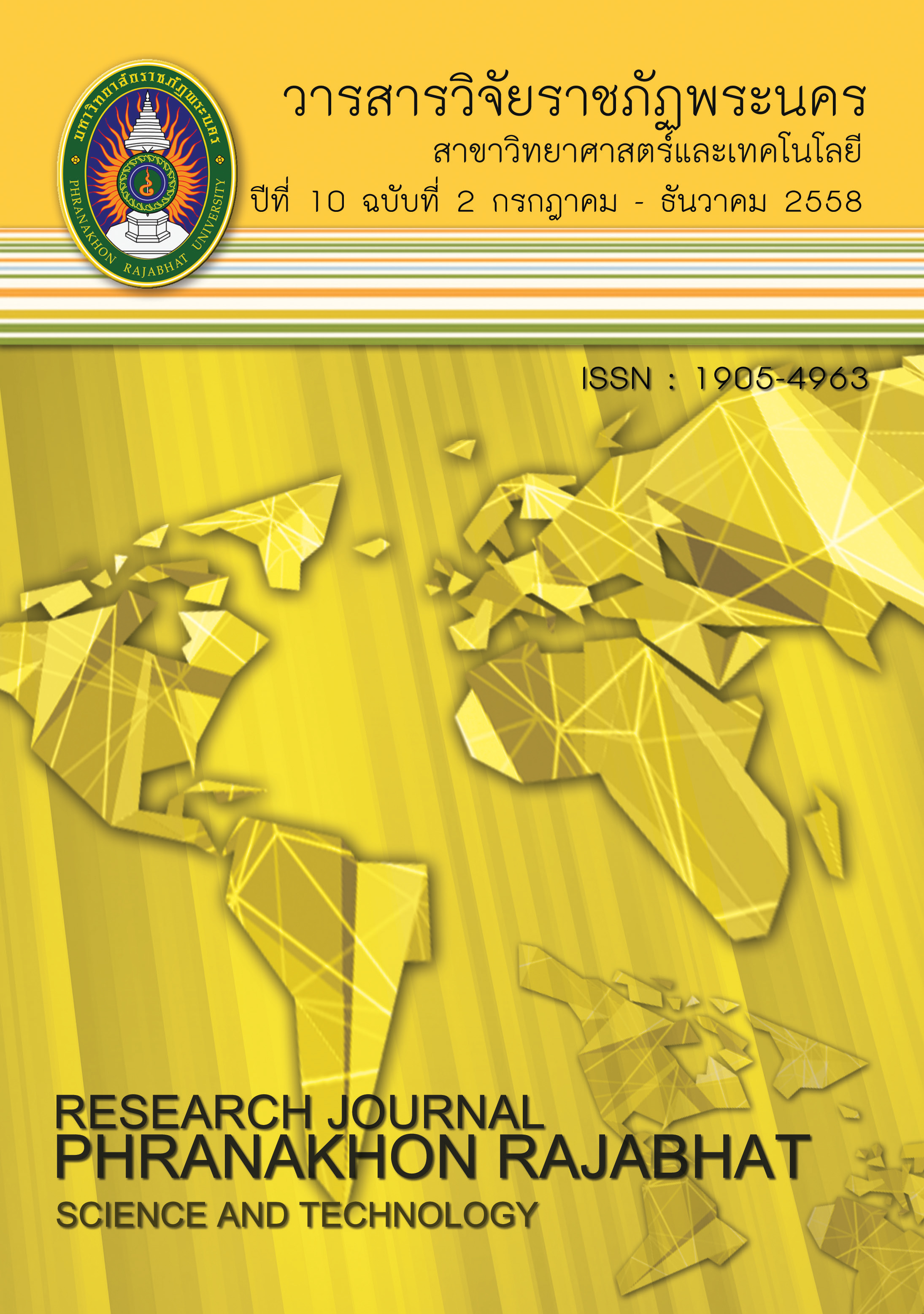การพัฒนาฐานข้อมูลเชิงพื้นที่ในการจำแนกการใช้ประโยชน์ที่ดินจากข้อมูลดาวเทียม SMMS ในพื้นที่ภาคตะวันตกของประเทศไทย
Keywords:
ดัชนีภาพสีผสม, ดัชนีการจำแนกการใช้ประโยชน์ที่ดิน, ฐานข้อมูลเชิงพื้นที่, Color Composition Index, Land Use Index, Spatial DatabaseAbstract
การวิจัยครั้งนี้เป็นรูปแบบการวิจัยเชิงประยุกต์ โดยใช้วิธีการวิจัยแบบผสมผสานระหว่างการวิจัยเชิงปริมาณและการวิจัยเชิงคุณภาพในลักษณะของการพัฒนาริเริ่มสร้างสรรค์สิ่งใหม่ โดยใช้วิธีดำเนินการวิจัยด้วยการวิเคราะห์ข้อมูลดาวเทียม SMMS ในแต่ละช่วงคลื่น (แบนด์) จำนวน 4 แบนด์ เพื่อสร้างดัชนีภาพสีผสมจากข้อมูลดาวเทียม SMMS ในพื้นที่ภาคตะวันตกของประเทศไทย ได้แก่ แบนด์ 1 (ช่วงคลื่นสีนํ้าเงิน) ความยาวช่วงคลื่น 0.43-0.52 ไมโครเมตร แบนด์ 2 (ช่วงคลื่นสีเขียว)ความยาวช่วงคลื่น 0.52-0.60 ไมโครเมตร แบนด์ 3 (ช่วงคลื่นสีแดง) ความยาวช่วงคลื่น 0.63-0.69 ไมโครเมตร และแบนด์ 4 (ช่วงคลื่นอินฟราเรดใกล้) ความยาวช่วงคลื่น 0.76-0.90 ไมโครเมตร โดย นำข้อมูลมาซ้อนทับกันได้ครั้งละ 3 แบนด์ ไม่ซํ้ากัน และทำให้แต่ละแบนด์ที่เป็นสีขาวดำแทนด้วยแม่สีบวก 3 สีหลัก คือ สีนํ้าเงิน สีเขียว และสีแดง แสดงดัชนีภาพสีผสมด้วยวิธีการเรียงสับเปลี่ยน จำนวน 24 ดัชนี ได้แก่ 123 124 132 134 142 143 213 214 231 234 241 243 312 314 321 324 341 342 412 413 421 423 431 และ 432 หลังจากนั้นนำข้อมูลดัชนีภาพสีผสมที่ได้มาวิเคราะห์เพื่อสร้างดัชนีการจำแนกการใช้ประโยชน์ที่ดิน โดยประยุกต์ใช้หลักการแปลตีความข้อมูลด้วยสายตา และหลักการพิจารณาการแปลตีความข้อมูลดาวเทียม ตามมาตรฐานการจำแนกการใช้ประโยชน์ที่ดิน 3 ระดับ พบว่า สามารถวิเคราะห์ดัชนีการจำแนกการใช้ประโยชน์ที่ดินได้ 15 ดัชนี ได้แก่ ตัวเมืองและย่านการค้า (U1) สนามบิน (U401) สนามกอล์ฟ (U602) นาข้าว (A1)พืชไร่ (A2) ไม้ยืนต้น (A3) สถานที่เพาะเลี้ยงสัตว์นํ้า (A9) สถานที่เพาะเลี้ยงกุ้ง (A903) ป่าไม่ผลัดใบ (F1) ป่าผลัดใบ (F2) ป่าเลน (F3) พื้นที่ทะเล (W1) แม่นํ้าลำคลอง (W101) อ่างเก็บนํ้า (W201) และถนน (R)
This applied research was conducted by employing both methods from a quantitative research and a qualitative one in the innovative ways. The research investigates on the satellite data of four bands from SMMS (Small Multi-Mission Satellite). Each band was analyzed to create color composition indices of the West areas of Thailand. The four bands consisted of Band 1 (Blue Band) which had a wavelength of between 0.43-0.52 micrometers, Band 2 (Green Band) which had a wavelength of between 0.52-0.60 micrometers, Band 3 (Red Band) which had a wavelength of between 0.63-0.69 micrometers, and Band 4 (Near Infrared Band) which had a wavelength of between 0.76-0.90 micrometers. Then, the satellite data were three-layered overlaid in non-repeated arrangements. Any band showing grayscale would have been substituted by 3 additive primary colors which were blue, green, and red. The arrangements were permutated into 24 indices: 123, 124, 132, 134, 142, 143, 213, 214, 231, 234, 241, 243, 312, 314, 321, 324, 341, 342, 412, 413, 421, 423, 431, and 432. The data of color composition indices was later analyzed in order to create the land use indices. The visual interpretation and the 3 levels of land use classification were used at this procedure. The result reveals that the land use was
classified into 15 indices: City, Commercial and Services (U1), Airport (U401), Golf Course ( U602), Paddy Field (A1), Field Crop (A2), Perennial (A3), Aquacultural Land (A9), Shrimp Farm (A903), Evergreen Forest (F1), Deciduous Forest (F2), Mangrove Forest (F3), Marine (W1), River, Canal (W101), Reservoir (W201), and Road (R).
Downloads
Published
Issue
Section
License
โปรดกรอกเอกสารและลงนาม "หนังสือรับรองให้ตีพิมพ์บทความในวารสารวิจัยมหาวิทยาลัยราชภัฏพระนคร สาขาวิทยาศาสตร์และเทคโนโลยี" ก่อนการตีพิมพ์




